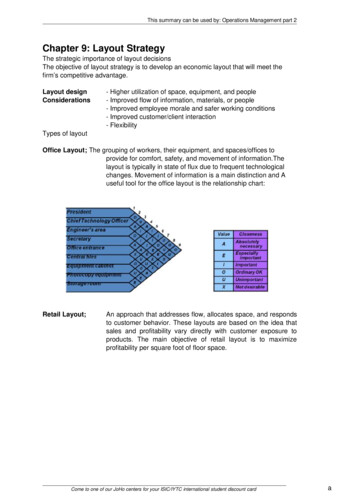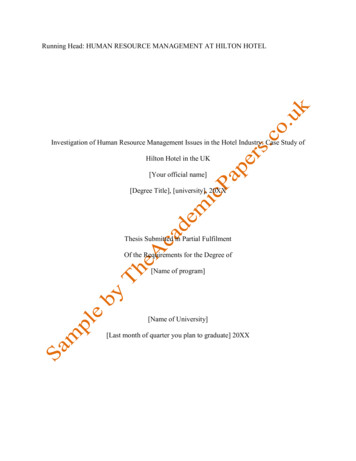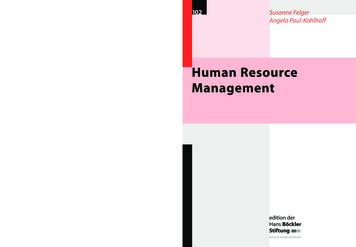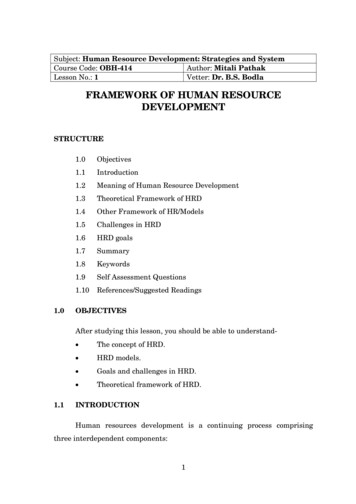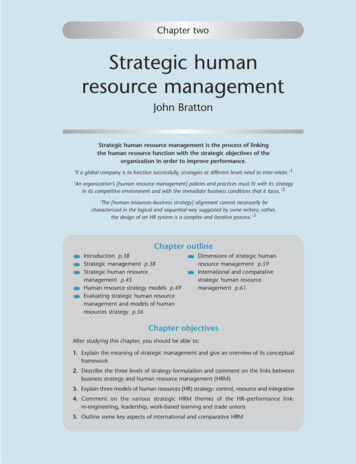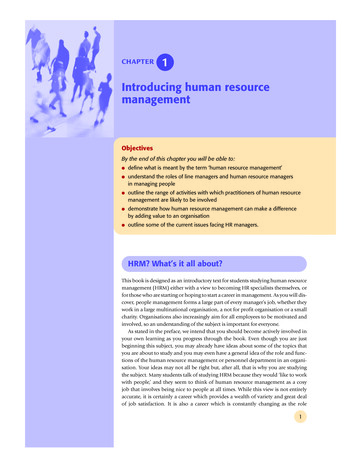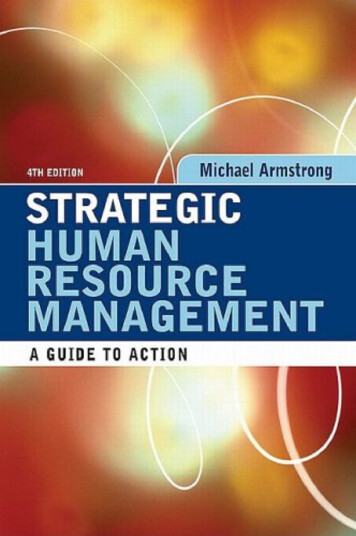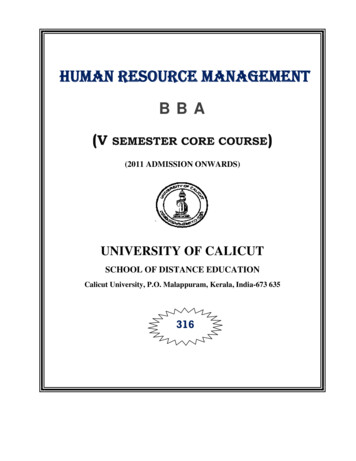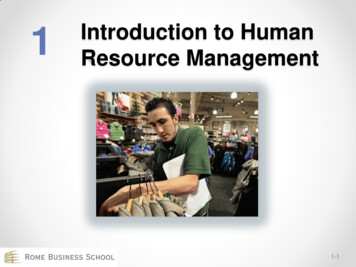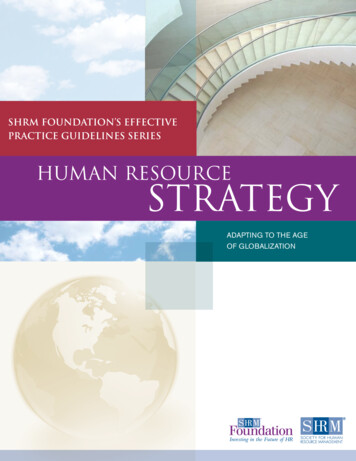
Transcription
SHRM Foundation’s EffectivePractice Guidelines SeriesHuman ResourceStrategyAdapting to the Ageof Globalization
SHRM Foundation’s Effective Practice Guidelines SeriesStrategyHuman ResourceAdapting to the Age ofGlobalizationby Patrick M. Wright, Ph.D.
Human ResourceStrategyThis publication is designed to provide accurate and authoritative information regarding the subject matter covered. Neither the publisher nor the author is engaged in rendering legal or other professional service. If legal advice or other expert assistance is required,the services of a competent, licensed professional should be sought. Any federal and state laws discussed in this book are subject tofrequent revision and interpretation by amendments or judicial revisions that may significantly affect employer or employee rights andobligations. Readers are encouraged to seek legal counsel regarding specific policies and practices in their organizations.This book is published by the SHRM Foundation, an affiliate of the Society for Human Resource Management (SHRM ). Theinterpretations, conclusions and recommendations in this book are those of the author and do not necessarily represent those of theSHRM Foundation. 2008 SHRM Foundation. All rights reserved. Printed in the United States of America.This publication may not be reproduced, stored in a retrieval system or transmitted in whole or in part, in any form or by any means,electronic, mechanical, photocopying, recording or otherwise, without the prior written permission of the SHRM Foundation, 1800Duke Street, Alexandria, VA 22314.The SHRM Foundation is the 501(c)3 nonprofit affiliate of the Society for Human Resource Management (SHRM). The SHRMFoundation maximizes the impact of the HR profession on organizational decision-making and performance by promoting innovation, education, research and the use of research-based knowledge. The Foundation is governed by a volunteer board of directors,comprising distinguished HR academic and practice leaders. Contributions to the SHRM Foundation are tax deductible. Visit theFoundation online at www.shrm.org/foundation.For more information, contact the SHRM Foundation at (703) 535-6020.08-0557
Table ofContentsvForewordviiAcknowledgmentsixAbout the Author1 Human Resource Strategy: Adapting to the Ageof Globalization3What Is HR Strategy?4Three Versions of a Generic HR Strategy6How HR Strategies Affect Performance9Real-World Impact of HR Strategies15Building Your Own HR Strategy20Future Challenges21Conclusion23Sources and Suggested Readings
ForewordDear Colleague:As a busy human resource practitioner, you probably find it difficultto keep up with the latest academic research in the field. Yet knowingwhich HR practices have been shown by research to be effective canhelp you in your role as an HR professional.That’s why the SHRM Foundation created the Effective PracticeGuidelines series. These reports distill the latest research findings andexpert opinion into specific advice on how to conduct effective HRpractice. Written in a concise, easy-to-read style, these publicationsprovide practical information to help you do your job better.The Effective Practice Guidelines were created in 2004. The SHRMFoundation publishes new reports annually on different HR topics.Past reports, available online at www.shrm.org/foundation, includePerformance Management, Selection Assessment Methods, EmployeeEngagement and Commitment, Implementing Total Rewards Strategies,Developing Leadership Talent and Retaining Talent. You are nowreading the seventh report in the series: Human Resource Strategy.For each report, a subject matter expert is chosen to be the author.After the initial draft is written, the report is reviewed by bothacademics and practitioners to ensure that the material is research-based,comprehensive and presented in an easy-to-use format. An annotatedbibliography, “Sources and Suggested Readings” section, is includedwith each report as a convenient reference tool.This process ensures that the advice you receive in these reports is notonly useful, but based on solid academic research.Our vision for the SHRM Foundation is to “maximize the impact ofthe HR profession on organizational decision-making and performance,by promoting innovation, education, research and the use of researchbased knowledge.” In addition, the Foundation is strategically focusedon initiatives designed to help organizations maximize leadership talent.We are confident that the Effective Practice Guidelines series takes usone step closer to making that vision a reality.Frederick P. Morgeson, Ph.D.Chair, SHRM Foundation Research Applications CommitteeProfessor and Valade Research Scholar, Michigan State Universityv
AcknowledgementsThe SHRM Foundation is grateful for the assistance of the following individualsin producing this report:Content EditorFrederick P. Morgeson, Ph.D.Professor and Valade ResearchScholarThe Eli Broad Graduate School ofManagementMichigan State UniversityDan Henry, Sr.Chief Human Resource OfficerBright Horizons Family SolutionsReviewersSumita Raghuram, Ph.D.Associate Professor of HumanResource ManagementDepartment of Labor Studies andEmployment RelationsPennsylvania State UniversityRajiv Burman, SPHR, CCP,CEBS, CHRPVice President Human Resources,USA & CanadaGriffith LaboratoriesJames R. Schultz, SPHR, GPHRVice President-HR, GlobalDownstreamChevron CorporationJohn E. Delery, Ph.D.Professor and Raymond F. Orr ChairDepartment of ManagementSam M. Walton College of BusinessUniversity of ArkansasProject ManagerBeth M. McFarland, CAEManager, Special ProjectsSHRM FoundationMark FogelCorporate Vice President HR andCustomer CareLeviton Manufacturing Co., Inc.Major funding for the Effective Practice Guidelines series is provided by the HRCertification Institute and the Society for Human Resource Management.vii
About the AuthorPatrick M. WrightDr. Wright is the William J. Conaty GE Professor of Strategic HumanResources in the School of Industrial and Labor Relations at CornellUniversity. He is also a Senior Research Fellow in the School of SocialSciences at Tilburg University. He holds a BA in psychology fromWheaton College and an MBA and a Ph.D. in organizational behavior/human resource management from Michigan State University. ProfessorWright teaches, conducts research and consults in the area of strategichuman resource management, particularly focusing on how firms relyon people as a source of competitive advantage. He has published morethan 60 research articles, 20 chapters in books and edited volumes, coauthored a leading human resource management textbook, now in its6th edition, and co-authored or co-edited six books.He has taught in Executive Development programs at CornellUniversity, University of Southern California and Texas A&M and hasconducted programs and/or consulted for a number of large public andprivate sector organizations. Dr. Wright served as the Chair of the HRDivision of the Academy of Management and on the Board of Directorsfor the SHRM Foundation, World at Work and Human ResourcePlanning Society. He was inducted as a Fellow in the National Academyof Human Resources in 2005 and won the 2007 HRM Scholar Awardfrom the Dutch HRM Network.ix
HR strategies need to simultaneously focus on building skills,motivation and behavior for a successful business strategy.
Human Resource StrategyHuman Resource Strategy:Adapting to the Age ofGlobalizationGlobalization of individual companies and capital markets over the past twodecades has changed the business landscape. Many firms have expandedoperations overseas, and even strictly domestic businesses are facing competitionfrom abroad. To respond to global competition, firms are using newtechnologies to provide better, lower-cost solutions for their customers, butthese technological innovations have led to constant movement of customersand competitors. At the same time, global capital markets are pressuring firmsto innovate and reduce costs—not an easy feat. All of these trends are pushingcompanies to manage their assets as effectively as possible—especially theirhuman assets.This report will explore a variety of ways to adapt your overall HR strategyto the new realities of global competition. Let’s first take a look at how onecompany responded to these new pressures.Delta Air Lines: From Clear Skies to Crash LandingIn the 1970s and 1980s, Delta Air Lines became the premier U.S. airlinefor customer service with a culture of “southern hospitality” and employeeswho went above and beyond the call of duty. The company’s human resourcestrategy helped build the skills, motivation and opportunities for employeesto deliver great customer service, and that allowed Delta to attract businesstravelers who paid premium prices for travel. Delta’s success shows just howimportant HR strategy can be, especially in its impact on company performance.Figure 1: Delta Air Lines: Pre-1994 Business ModelDriven byDelivered byInternal promotionExtensive trainingHigh payNon-unionFlexible work rulesFamily d rofitsCostsCore Competence1
Human Resource StrategyHow did Delta do it? A great reputation in the industryenabled Delta to recruit and selectonly the best employees who hadskills and attitudes that fit well intothe company’s family-orientedculture. Delta invested more than mostairlines in training. Non-union status allowed forflexible work rules that letemployees react to any situationand get the job done. Delta’s internal promotion systemled to long employee tenure anda workforce with a wealth ofexperience and knowledge. Relatively high pay also encouragedemployees to stay with Delta for thelong haul because they believed thecompany cared about them.Before 1994, as seen in Figure 1,Delta’s HR strategy was perfectlyaligned with its business strategy so thatHR practices built employees’ skills andmotivation to make the business work.But by the 1990s, things werechanging. Major business trendsaltered the competitive climate, andHR strategy had to change too. In1994, after two straight years of recordfinancial losses, CEO Ron Allen rolledout a new strategy called “Leadership7.5.” Allen aimed to reduce Delta’s costper available seat mile (CASM) frommore than 10 cents to 7.5 cents, whichwould match that of major competitorSouthwest Airlines. Along with anew business strategy came a massivetransformation of Delta’s HR strategy.In Delta’s new HR strategy: Training dollars were cut. Experienced employees were laidoff and replaced with contingentemployees. Delta put fewer flight attendants oneach flight and fewer mechanics atthe gates. Pay was frozen or cut for just aboutall employee groups.The Delta business model and HRstrategy now resembled Figure 2.Figure 2: Delta Air Lines: Post-1994 Business Model (Leadership 7.5)Driven byDelivered byValuedCustomerOutcomeRevenuesLayoffsLow wagesLow mporarylow tenureCompetitive(low) costtravelProfitsCosts2
Human Resource StrategyFigure 3: How the IBM HR Strategy Supports and Enables the Business StrategyIBM StrategYPerformance-Based tiors:The EmployeeExperienceLeadershipDiverse, Talented PeopleFlexibilityValues-based ClimateFocus onenterprises thatvalue Anticipate and Build SkillsHumanResourceFocus AreasAn inspiringclimate in whichemployees flourishby creating valuefor our clients andthe worldLead the TransformationDespite what is obviously athoughtful process of developingHR strategy, the chart andexplanation above fall flat becausethey lack concrete guidance aboutspecific ways that you could adaptHR practices to your own situation.That’s why this report uses a specificdefinition of HR strategy, designedto give you that concrete guidanceand help you identify specificpractices that are adaptable for you.Grow IBMGetting Down to SpecificsAs an HR professional, you areresponding to the same economictransformations that drove thechanges at Delta. You need access tothe most recent research on how tomake employees a source of longterm competitive advantage underthe pressures of globalization. ThisSHRM Foundation report gives youaccess to the research, principles,guidelines and tools for creating anHR strategy that will add value toyour organization. The first step is tounderstand what HR strategy is.What is HR strategy?If you ask the CEO of a largemultinational company to explainHR strategy, you’ll probably get apretty general description of howHR supports his or her business.Computer giant IBM, for example,has a well-articulated HR strategy, asshown in Figure 3.1) innovation, 2) business value, 3)global integration, and 4) on-demandinfrastructure. Behind this overallstrategy are all of the employees whomake it work. IBM’s HR strategyidentifies company characteristicsthat motivate and energize thoseemployees.IBM motivates itsemployees through: Performance-based opportunities. Leadership. Hiring diverse and talented people. Flexibility. A values-based climate.But what role does HR play inbuilding the ideal IBM workforce?Again, at IBM, the goals are clear.At IBM, HR is expected to: Anticipate and build skills.IBM’s HR StrategyAs you can see, IBM’s overall businessstrategy focuses on four areas: Lead transformation. Grow IBM.For our purposes, HR strategymeans a system of human resourcepractices for a particular job orcollection of jobs aimed at the bestemployee performance possible tomeet the firm’s ultimate goals. This definition of HR strategyemphasizes the system of HRpractices, because it is thebroad array of practices thatmatter in terms of employeeperformance—not individualtests, recruiting or interviewtechniques, for example. It is also important to rememberthat HR strategies are bestdesigned and implemented fora particular job or a set of jobs.Few firms manage their clericalworkers the same way theymanage their senior executives.Each group is recruiteddifferently, is selected accordingto different criteria, attendsdifferent training programs and ispaid differently. If your companyis focused on customer service,you’ll need to build customerservice skills and behaviors intoall customer-oriented jobs,3
Human Resource StrategyKEY TERMSStrategic HRMHR StrategyHR Best PracticesFocusHuman capitalHuman resourcepractice systemSingle HR practiceLevel ofinterestOrganization or businesslevelJob levelJob levelResponsibilityDesigned jointly betweenline and HRDesigned mostly by HRDesigned entirelyby HRGet the right people inthe right place in thebusiness to maximizebusiness successGet people to have(skills), feel (attitudes)and do (behaviors)things that lead to joband business successGet people to have(skills), feel (attitudes)or do (behaviors)something that leadsto job successGoal orobjectiveCommitment vs.Control StrategiesTwo very different overall HRstrategies, labeled “commitment” and“control,” have been identified andanalyzed (Arthur, 1992).The commitment HR strategy wouldinclude: Broadly defined tasks. H igh levels of employee participation. Highly skilled workers.but your specific strategy ofrecruitment, selection, trainingand rewards for a cashier will bedifferent from those of a storemanager. Finally, the best HR strategiesalways stay focused on getting thebest performance from employees.Usually, this means gettingemployees to: Have something (skills,competencies, abilities). Feel something (commitment,engagement, motivation). Do something (come towork, be productive, servecustomers, stay with theorganization).If your HR practices are correctlydesigned and put in place, you’llget the best employee performance,which means you’ll get the bestoverall company performance as well.Strategic Human ResourceManagement, HR Strategy andHR Best PracticesThe chart above provides acomparison of strategic humanresource management (HRM), HR4strategy and HR best practices—termsthat are often used interchangeablybut are actually very different. Theydiffer in their primary focus, HRinvolvement and ultimate goals—butall will be components of your overallHR strategy.Three Versions of a GenericHR StrategyThe HPWS ApproachOften, when you’re consideringhow HR practices influence yourfirm’s performance, you may focuson training or staffing practices.However, as shown in the Key Termsabove, these are more “best practices”than strategies. One landmark study(Huselid, 1995) created a popularframework that can be used as a kindof generic HR strategy. The frameworkis known as the high-performance worksystem (HPWS) and is explained inTable 1 on page 6.Implementing all of the practicesoutlined in Table 1 as part of theHPWS approach is probably in thebest interest of any company becauseHPWS improves firm performanceand works well across many differentorganizations. Extensive training. High wages. High benefits.However, the control HR strategywould represent the opposite: Narrowly defined jobs. Low participation. Low skill requirements. Intense supervision or control. Limited training. Low wages. Low benefits.In practice, as you might expect, thecommitment strategy generally leadsto the best firm performance forthose using a differentiation businessstrategy, but the control strategymay work best for firms with a costbusiness strategy. In real-life terms,the two strategies go head to headin a comparison of Costco andWal-Mart in Box 1.The Value Matrix ApproachThe HPWS approach suggests that itcan fit all firms, regardless of
Human Resource StrategyFirms can distinguish the skill sets ofparticular jobs in terms of their valueto the firm and their uniqueness in thelabor market. In this value/uniquenessmatrix, known as the human capitalarchitecture, each quadrant includesdescriptions of the appropriate HRstrategy, as seen in Figure 4.Is There an Ideal GenericHR Strategy?Keep in mind that all of these attemptsto create generic HR strategies aresimply different points on a spectrum.At one end of the spectrum is theBox 1InternalizationStrategic HC Commitment-based- staff based on potential- develop (firm-specific)- a utonomy/self-direction- extensive pay andbenefits- “fail” forwardRelationalSupport HC Compliance-based- limited scope(outsource)- rules and procedures- contract/hourly pay- error avoidingCore HC Performance-based- staff on current need/skill- targeted development- market-driven pay- reward productivity- mistakes above waterlinelowStrategic Valuehighgoal of overall employee engagement,where HR practices elicit high levelsof skill, motivation and attitudes thatencourage workers to contributeproactively and stay with the firm. Atthe other end are HR practices thatseek to minimize the costs associatedwith managing employees whilemaintaining sufficient work design andcontrols to be sure that they do theirjobs. One study put it this way:“The goal of control human resourcesystems is to reduce direct laborSam’s Club vs. CostcoSam’s ClubCostcoProfit per employee 11,615 21,805Average hourly wage 10.11 17.00Percent with health care 50%82%Percent of health care premiums paid33%8%Turnover44%17% 5,274 3,628Turnover cost per employeeCostco vs. Wal-Mart:Battle of the Bulk StoresCollaborative HC Partnership- select on pastexperience- develop therelationship- evolving scope- rewards for ideasTransactionalhighExternalizationUniquenessA third possibility is the value matrixapproach (Lepak and Snell, 1999),which says that a firm can implementfour possible HR strategies(commitment, performance,compliance and partnership) tied tofour distinct job groups representingdifferent types of workers (strategic,core, support or collaborative).Figure 4: Human Capital Architecturelowoverall business strategy, while thecommitment/control approachsays that different HR strategies areappropriate to different businessstrategies.Wal-Mart has been an amazinglysuccessful company. But overthe past few years, the companyhas faced increasing competitionand scrutiny of its HR strategies,which have long focused onlow workforce costs as a means ofkeeping prices low.Sam’s Club, the bulk division ofWal-Mart, has been competingagainst Costco in recent years.In a thorough comparison ofthe HR strategies and businessresults of these two companies(Cascio, 2006), Costco wasshown to invest more in itssales associates through pay andhealth care benefits and to workwith unions rather than activelyfighting against unions, as WalMart does.Most importantly, despite thefact that Costco pays higherwages, it actually has lower laborcosts and higher profitability peremployee than does Wal-Mart.The study concluded:“These figures illustrate nicelythe common fallacy that laborrates equal labor costs. Costco’shourly labor rates are 40%higher ( 17 vs. 10.11), butwhen employee productivity isconsidered (sales per employee),Costco’s labor costs are lowerthan those at Sam’s Club (5.5%at Costco compared to 6.25% atSam’s Club.)”Source: Casico, W. The high cost of low wages. Harvard Business Review.5
Human Resource Strategycosts or improve efficiency, byenforcing employee compliancewith specified rules and proceduresand basing employee rewards onsome measurable output criteria[ ] Commitment human resourcesystems shape employee behaviors andattitudes by forging psychologicallinks between organizational andemployee goals. In other words, thefocus is on developing committedemployees who can be trusted touse their discretion to carry outtasks in ways that are consistent withorganizational goals.” (Arthur, 1992)Although you may personally preferto aim toward “developing committedemployees,” some firms succeedfinancially by taking the route of“enforcing employee compliance.”In the end, you can aim HRstrategies at investing in humancapital by building skills andmotivation of the workforceand providing opportunities toparticipate, or you can aim atminimizing the cost of your humancapital by controlling behavior,lowering the skill level of jobs andlimiting opportunities to participatein decision-making in the firm.Delta’s Leadership 7.5 strategycertainly resembled a transformationfrom a commitment to a controlHR strategy. But the question is:How did the new HR strategy affectDelta’s company performance?How HR Strategies AffectPerformanceResearchers have found a significantrelationship between HR strategiesand profitability. However, this6Table 1: Components of a High-Performance Work System Strategy: A Questionnaire1. What proportion of the workforce is included in a formal information-sharing program,such as a newsletter?2. What proportion of workers have had a formal job analysis?3. What proportion of non-entry-level jobs have been filled from within in recent years?4. What proportion of the workforce is administered attitude surveys regularly?5. What proportion of the workforce participates in Quality of Work Life (QWL) programs,Quality Circles (QC) and/or labor-management teams?6. What proportion of the workforce has access to company incentive plans, profit-sharingplans and/or gain-sharing plans?7. W hat is the average number of hours of training for a typical employee over the last 12months?8. W hat proportion of the workforce has access to a formal grievance procedure and/orcomplaint resolution system?9. W hat proportion of the workforce takes an employment test prior to hiring?10. What proportion of the workforce has performance appraisals to determinecompensation?11. What proportion of the workforce receives formal performance appraisals?12. Which of the following promotion decision rules is used most often?a. Merit of performance rating alone.b. Seniority only if merit is equal.c. Seniority among employees who meet a minimum merit requirement.d. Seniority.13. For each of the five positions that your firm hires most frequently, how many qualifiedapplicants are there, on average?research has seldom identified howthis relationship works. Figure 5illustrates one model based onwhat employees have, how theyfeel and what they do. You havealready seen that the primary impactof HR practices is on the workersthemselves—the human capital. Let’slook more closely at the human capitalthrough the analysis of this model.What Employees Do is Based onWhat They Have and FeelThe initial impact of HR practicesis on what employees have and feel.Recruitment, selection, trainingand development are all aimed atbringing in or building certain skills,enabling employees to effectivelyperform their jobs. In addition,their experience with these practices,along with rewards, performancemanagement and communication,shapes workers’ perceptions of thecompany’s fairness and desirability.And those perceptions then influencetheir commitment, motivation andengagement.
Human Resource Strategy What employees do is largely afunction of what they have, becausethey cannot be productive if theydon’t have the right skills. What they do is also a function ofwhat they feel, because they maychoose not to be productive if theyhave negative feelings toward theorganization.Ultimately, HR strategy has the mostsignificant impact on what employeesactually do on the job. If the strategyfocuses on customer service, forexample, it will affect things likewhether employees are friendlyand helpful, whether they give theright answers and solve customers’problems. If the strategy is aboutefficiency, it will encourage employeesto look for ways to lower costs oroperate more efficiently. Do theyengage in cost-saving behavior orwaste time and money? The bottomline is that what employees actuallydo will decide how well the businessstrategy is executed.In the end, what employees dois the critical link in executingstrategy. Because what employeesdo depends on what they have andfeel, HR strategies need to focussimultaneously on building skills,motivation and behavior for asuccessful business strategy.Employee Actions AffectBusiness SuccessThere are five types of employeebehavior relevant to a company’ssuccess.1. Task behavior refers to things thatemployees are supposed to do aspart of their jobs (from the bareminimum to the maximum).2. Discretionary behavior refers toemployees using their discretionto go above and beyond their jobdescriptions—such as the airlinegate agent who races to return aforgotten briefcase.3. Counterproductive behavior is allthose things we do not want tosee our employees doing: stealingsupplies, taking long personalcalls, even sabotaging products orequipment.4. Attendance is the extent to whichemployees show up on time.Although perfect attendance isneither possible nor even desired(in the case of a sick employee),workers who call in sick when theyfeel fine create scheduling hasslesand reduce productivity.5. Turnover, of course, refers to anemployee leaving the organization.Again, zero turnover is neitherpossible nor desired, but excessiveturnover of average employeesresults in additional replacementcosts, and turnover of anoutstanding employee (if replacedby a less skilled employee) mayresult in a permanent decrease inproductivity.In discussing HR strategy, productivityis usually measured using the numberof products produced or delivereddivided by the number of full-timeemployees (FTEs) or number of laborhours. If employees are engagedin positive behaviors, fewer will beneeded for a high level of output. Onthe other hand, careless or deliberatemistakes and negative employeebehavior can cause product defects,some of which can’t be repaired.In some industries—such as miningand refining—accidents can be costlyor fatal, and HR strategies must bedeveloped to encourage safe behaviorof employees.Employee ActionsAffect CustomersAny employee who interacts withcustomers has the potential to elicitpositive or negative experiences. Box2 describes the author’s personalexperience of how an HR strategy hasFigure 5: HR Strategy and PerformanceHR s HaveSkillsAbilitiesCompetenciesWhatEmployees FeelMotivationCommitmentEngagementWhatEmployees DoTask behaviorDiscretionary ialOutcomesExpensesRevenuesProfits7
Human Resource StrategyBox 2Flying the Not-So-Friendly SkiesLiving in Ithaca, New York, one does not have a lot of options forflying from the local airport, which happens to be only five minutesfrom my house. I have flown for the past 11 years on one of the fewairlines serving Ithaca, logging over 100,000 miles per year, with sevento 10 full-fare business class tickets each year. In fact, two years ago,they recognized me as one of their top 500 fliers.Facing bankruptcy, the airline recently engaged in a cost-cuttingstrategy that required workers to take a 30 percent pay cut and laterhave their pensions handed over to the Pension Benefit GuaranteeCorporation, resulting in an estimated 70 percent cut in their pensionvalue. The management defined a set of standard operating proceduresfor employees to follow to control costs, and they have little discretion.Needless to say, as the situation developed, the employees were notfeeling positive about their employer and certainly were not generatingpositive customer impressions. Many would make derogatorycomments about the airline. Rather than doting on first-classpassengers as they had in the old days, flight attendants now wouldserve a drink or a meal and then sit in their jump seats reading untila customer rang the call button. These flight attendants exhibitedonly the minimum level of task behavior, no discretionary behavior andconsiderable counterproductive behavior. I continued to fly with theairline because I assumed that in this era of turmoil in the industry, allairlines were in the same situatio
authored a leading human resource management textbook, now in its 6th edition, and co-authored or co-edited six books. H


